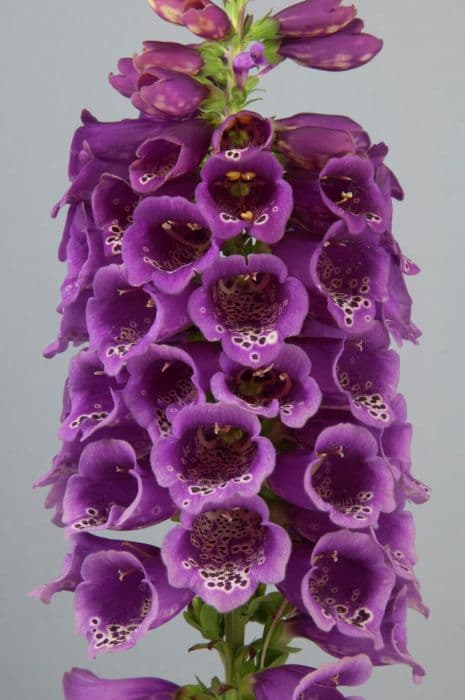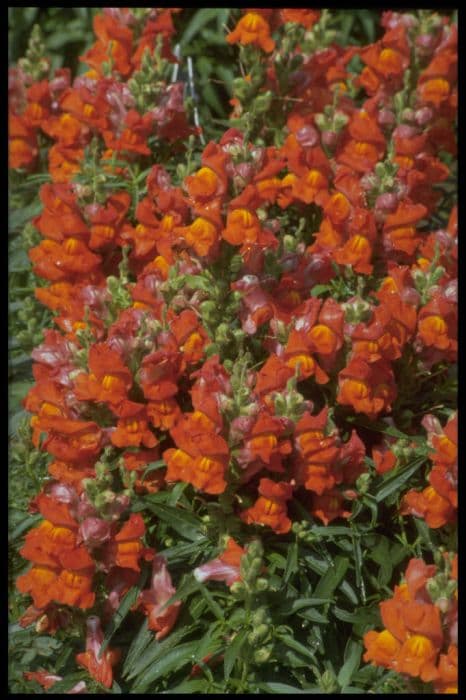Foxglove Digitalis purpurea 'Purple Carousel' (Carousel Series)

ABOUT
Digitalis purpurea 'Purple Carousel', more commonly known as foxglove, is a striking perennial widely admired for its elegant and vivid display. This variety features a rosette of green, oblong leaves from which a spike emerges, showcasing an array of bell-shaped flowers. These blossoms are arranged in a dense cluster along the spike, each flower nodding gracefully. Their color is a sumptuous purple with speckled throats, often accentuated with various shades of pink and white spots within the corolla, creating an enchanting, mottled appearance that is very attractive to bees, hummingbirds, and other pollinators. The foxglove's flowers are perfectly designed to accommodate pollinating visitors, with a lower lip that serves as a landing platform. The petals of the foxglove have a soft, velvety texture, contributing to its traditional, cottage garden appeal. The blooms can give an appearance of a carousel due to their whorled arrangement around the stem which may have contributed to the cultivar's name. After flowering, the plant produces small capsules containing numerous tiny seeds. Overall, the 'Purple Carousel' foxglove is a captivating plant, cherished for the stately spikes of tubular flowers that create a visually engaging display in garden beds and borders.
About this plant
 Names
NamesFamily
Plantaginaceae
Synonyms
Common Foxglove, Purple Foxglove, Lady's Glove, Fairy Gloves, Witches' Gloves
Common names
Digitalis purpurea 'Purple Carousel'.
 Characteristics
CharacteristicsLife cycle
Biennials
Foliage type
Deciduous
Color of leaves
Green
Flower color
Purple
Height
2-3 feet (60-90 cm)
Spread
1-2 feet (30-60 cm)
Plant type
Herb
Hardiness zones
4-9
Native area
Europe
Benefits
 General Benefits
General Benefits- Ornamental Appeal: Adds aesthetic value to gardens with its tall spikes of tubular purple flowers.
- Attracts Pollinators: Serves as a food source for bees, butterflies, and hummingbirds, promoting pollination.
- Drought Tolerance: Once established, it has a degree of drought resistance, making it suitable for xeriscaping.
- Shade Tolerance: Can perform well in partial shade, offering flexibility in garden placement.
- Long Blooming Period: Flowers in late spring to early summer, providing colour for an extended period.
- Vertical Interest: The plant's height adds a dimensional aspect to garden beds and borders.
- Deer Resistance: Less palatable to deer, which can help to minimize plant damage in areas with deer populations.
 Medical Properties
Medical Properties- Cardiac glycoside content: Digitalis purpurea, commonly known as Foxglove, contains cardiac glycosides which are used in medications to treat certain heart conditions.
- Positive inotropic effect: The cardiac glycosides present in the plant can increase the force of heart muscle contractions, which can be beneficial in treating heart failure.
- Regulation of heart rate: Cardiac glycosides from Foxglove are utilized for their properties in regulating heart rate in patients with certain types of cardiac arrhythmias.
 Air-purifying Qualities
Air-purifying QualitiesThis plant is not specifically known for air purifying qualities.
 Other Uses
Other Uses- Digitalis purpurea, commonly known as Foxglove, can be used as a natural dye, providing various shades of green depending on the mordant used.
- The dried leaves of Foxglove have been historically used to stuff pillows, believed to help people sleep by inducing mild paralysis due to its toxic properties.
- Foxglove is sometimes used in small quantities in compost piles to deter rodents and other pests with its toxic compounds.
- Foxglove flowers are attractive to bumblebees and can be planted to specifically encourage bumblebee activity in the garden.
- The tall and dramatic spikes of Foxglove can be used artistically in photography to create a fairytale or ethereal aesthetic in garden settings.
- Some cultures have used Foxglove in folklore rituals and ceremonies, associated with magic and the spirit world due to its toxic and medicinal nature.
- Foxglove can be featured in educational settings like botanical gardens to illustrate the concept of "digitalization," the effect of its active compounds on the heart.
- The plant can be used in natural planting schemes designed to simulate a wildflower or native planting environment for educational or ecological purposes.
- Used in flower language and symbolism, Foxglove may represent insincerity, due to its toxic nature, and is sometimes included in bouquets with this intention.
- In literature and art, the Foxglove plant can be used symbolically to reflect themes of allure and danger, due to its beautiful but deadly characteristics.
Interesting Facts
 Feng Shui
Feng ShuiThe Foxglove is not used in Feng Shui practice.
 Zodiac Sign Compitability
Zodiac Sign CompitabilityThe Foxglove is not used in astrology practice.
 Plant Symbolism
Plant Symbolism- Healing: The common name of Digitalis purpurea is "Foxglove," and this plant has been used in traditional medicine for its cardiac glycosides, symbolizing the power of healing and protection against heart problems.
- Bewitchment: Foxglove has mythical associations with fairies and the supernatural. Folklore suggests that the flowers are habitats for magical beings, representing enchantment and the thin boundary between reality and fantasy.
- Inspiration: The fairy tale connections of Foxglove also symbolize inspiration and creativity, stemming from its otherworldly associations and its ability to evoke a sense of wonder.
- Toxicity: Despite its beauty and medicinal uses, Foxglove is also highly toxic if mishandled or ingested. Its symbolism includes a reminder of the fine line between medicine and poison, illustrating the duality of nature.
- Pride: Foxglove's stately spires rising above other garden plants represent pride and ambition, inspiring one to stand tall and distinguished among their peers.
- Intuition: Due to its connection with the fairy realm and mysticism, Foxglove may also symbolize intuition and the ability to see beyond the evident, looking deep within to uncover hidden truths.
 Water
WaterFoxglove requires consistent moisture, especially during its growing season in the spring and early summer. It's best to water at the base of the plant to avoid wetting the foliage, which can lead to fungal diseases. They prefer not to dry out completely, so check the soil moisture regularly. During the peak growing season, watering once or twice a week with about 1 gallon of water per plant should suffice, depending on soil type and climate. Adjust the frequency during rainy periods or in extreme heat to ensure the soil stays evenly moist but not waterlogged.
 Light
LightFoxglove thrives in partial shade but can also tolerate full sun in cooler climates. The ideal spot would provide morning sunlight and afternoon shade, or dappled sunlight throughout the day, which resembles their native woodland habitat. Avoid placing them in deep shade, as this can reduce flowering and make the plants leggy.
 Temperature
TemperatureFoxglove prefers moderate temperatures and can survive in a range between 40 to 90 degrees Fahrenheit. They are hardy in many climates but may struggle in extreme heat or cold. The ideal temperature for optimal growth is between 60 to 80 degrees Fahrenheit.
 Pruning
PruningFoxglove should be pruned to remove spent flower spikes, encouraging the plant to produce more blooms and preventing self-seeding if not desired. After the main spike has finished blooming, cut it back to the base to promote side shoot development. Pruning is best done in late summer after flowering, but before seed pods fully develop.
 Cleaning
CleaningAs needed
 Soil
SoilThe Foxglove 'Purple Carousel' thrives in a well-drained, moist soil rich in organic matter with a pH of 5.5 to 6.5. A good mix can be made of equal parts loam, peat, and sand or perlite.
 Repotting
RepottingFoxgloves, such as 'Purple Carousel,' are biennials or short-lived perennials and typically do not need repotting as they are often sown directly into the ground and may be replaced after two to three seasons.
 Humidity & Misting
Humidity & MistingFoxglove 'Purple Carousel' prefers moderate humidity levels but is quite adaptable and can tolerate the humidity levels found in most temperate climates without issue.
 Suitable locations
Suitable locationsIndoor
Ensure bright light, cool temp., moist soil, and good air circulation.
Outdoor
Full sun to part shade, well-drained soil, protect from high winds.
Hardiness zone
4-8 USDA.
 Life cycle
Life cycleThe life of Digitalis purpurea, commonly known as common foxglove, typically begins as a seed which germinates in moist, rich soil during the spring after a period of cold stratification. The first year is spent growing basal rosettes of oblong leaves, after which the plant enters a period of dormancy during the colder months. In its second year, the foxglove sends up a tall flower spike adorned with tubular, purple-pink flowers that are visually striking and attractive to pollinators like bees and hummingbirds. After pollination, usually in late spring to early summer, the flowers produce small, numerous seeds within capsule-like fruits. These seeds disperse in late summer, capable of creating new plants if they land in suitable conditions. The plant is biennial, meaning it usually completes its life cycle in two years, after which it dies, though it can reseed and perpetuate itself in the garden if conditions are favorable.
 Propogation
PropogationPropogation time
Spring to Early Summer
Digitalis purpurea 'Purple Carousel', commonly known as Foxglove, is often propagated by seed. The ideal time to sow Foxglove seeds is late spring to early summer. Because Foxgloves are biennials or short-lived perennials, the sowing of seeds enables gardeners to continuously replenish their plants. To propagate by seed, surface sow the tiny seeds onto well-draining, moist seed starting mix, as they need light to germinate. Carefully press the seeds into the soil but do not cover them. Keep the soil temperature around 65°F to 70°F (18°C to 21°C) and maintain consistent moisture without oversaturating. Seedlings usually appear in 2 to 3 weeks, and once they are large enough to handle, they can be transplanted into individual pots or directly into the garden, taking care to space them about 12 to 15 inches (30 to 38 centimeters) apart to accommodate their mature size.









